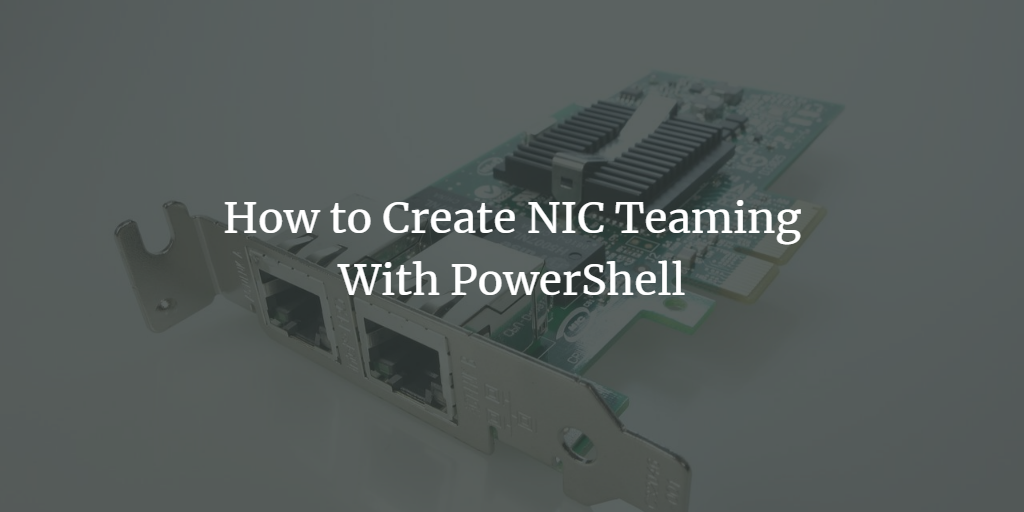As a Windows System administrator, you likely appreciate the efficiency of using Windows PowerShell to automate system administration tasks in Windows Server. This guide will show you how to create NIC Teaming using PowerShell.
Understanding NIC Teaming
NIC Teaming, also referred to as Load Balancing/Failover (LBFO), is a feature in Windows Server that enables you to group several physical Ethernet links into a single logical link. This enhances network performance, extends fault tolerance, and offers bandwidth aggregation.
Why use PowerShell for NIC Teaming?
Integrating PowerShell with NIC Teaming allows administrators to script routine tasks, manage networks, and alleviate system bottlenecks by leveraging its inbuilt cmdlets.
Creating NIC Teaming using PowerShell
Follow these steps to create NIC Teaming seamlessly with PowerShell. These examples were executed on Windows Server 2019, but the commands are similar across all Windows Server versions from 2012 onwards.
Combine network Adapters using NIC Teaming on Windows
To create NIC Teaming with two network adapters named NIC1 and NIC2, use the New-NetLbfoTeam cmdlet.
New-NetLbfoTeam -Name "MyTeam" -TeamMembers "NIC1","NIC2"
After executing this command, a team named "MyTeam" will be created which includes the network adapters NIC1 and NIC2.
View NIC Teaming status
To view the created NIC Teaming status, utilize the Get-NetLbfoTeam cmdlet.
Get-NetLbfoTeam -Name "MyTeam"
This command will provide you with a status report for the team named "MyTeam".
Add Network Adapter to a NIC Team
To add a new network adapter named NIC3 to an existing team, leverage on Add-NetLbfoTeamMember cmdlet.
Add-NetLbfoTeamMember -Name "NIC3" -Team "MyTeam"
Running this command will add the adapter named NIC3 to the team "MyTeam".
Remove Network Adpater from NIC Team
If you need to remove an adapter, say NIC2, from the team, employ the Remove-NetLbfoTeamMember command.
Remove-NetLbfoTeamMember -Name "NIC2" -Team "MyTeam"
"NIC2" will be removed from the "MyTeam" upon initiating this command.
Frequently Asked Questions
What is NIC Teaming?
NIC Teaming, also known as Load Balancing/Failover (LBFO), is a Windows feature that allows multiple network interfaces (NICs) to work together as a team, providing bandwidth aggregation and network redundancy to improve network performance and reliability.
How do I check if NIC Teaming is enabled on my Windows system?
Use the PowerShell command Get-NetLbfoTeam to check if NIC Teaming is enabled and to view existing teams. If nothing is returned, NIC Teaming is not set up.
How do I create a new NIC Team using PowerShell?
Use the New-NetLbfoTeam cmdlet. Syntax: New-NetLbfoTeam -Name "TeamName" -TeamMembers "NIC1","NIC2". Replace "TeamName" with your desired team name and "NIC1","NIC2" with the names of the NICs you want to include in the team.
How can I find the names of the network adapters to include in a NIC Team?
Use Get-NetAdapter | Select Name to list all network adapters and their names on your system. Use these names to specify the adapters in the NIC Teaming configuration.
Is it possible to configure the Load Balancing mode for a NIC Team using PowerShell?
Yes, when creating a team, use the -LoadBalancingAlgorithm parameter in the New-NetLbfoTeam cmdlet. Options include TransportPorts, IPAddresses, MacAddresses, HyperVPort, etc.
How can I add or remove NICs from an existing team?
To add a NIC, use the Add-NetLbfoTeamMember cmdlet. To remove, use the Remove-NetLbfoTeamMember cmdlet, specifying the team name and the NIC to be added or removed.
Can I change the Teaming Mode after creating a NIC Team?
Yes, use Set-NetLbfoTeam with the -TeamingMode parameter. Options are SwitchIndependent, LACP, and Static. Example: Set-NetLbfoTeam -Name "TeamName" -TeamingMode SwitchIndependent.
How do I remove a NIC Team using PowerShell?
Use the Remove-NetLbfoTeam cmdlet, specifying the team name. Example: Remove-NetLbfoTeam -Name "TeamName".
Are there any prerequisites or limitations for setting up NIC Teaming?
Yes, NIC Teaming requires compatible hardware and drivers. It's mainly supported on Windows Server editions, though some functionality might be available on client versions. Also, all NICs in a team should ideally be of the same speed and from the same manufacturer for optimal performance.
Where can I find more detailed information or troubleshooting help for NIC Teaming with PowerShell?
Microsoft's official documentation and TechNet forums are excellent resources for detailed information and community-based troubleshooting. Additionally, PowerShell's Get-Help cmdlet with the -Detailed flag can provide in-depth information on specific cmdlets used for NIC Teaming.
Conclusion
Using PowerShell to create NIC Teaming is easy and allows you to create robust, reliable and resilient network connections. With this guide, you can use the Windows PowerShell interface to configure NIC Teaming and optimize your network performance.
Note: Always ensure you have the correct permissions to conduct system administration tasks and that any changes you make are in line with your network management policies.
